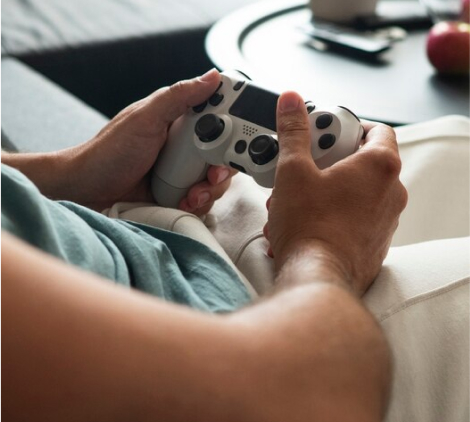How to calm down from a panic attack?
According to the National Institute of Mental Health, “An estimated 4.7% of U.S. adults experience panic disorder at some time in their lives.” [1] Panic Disorder is an anxiety disorder characterized by unexpected and repeated episodes of intense fear accompanied by physical symptoms that may include chest pain, heart palpitations, shortness of breath, dizziness, or abdominal distress. These episodes occur “out of the blue,” not in conjunction with a known fear or stressor.
Panic disorder is fairly common in the general population, and there are a lot of grounding techniques for panic attacks. It has the highest number of medical visits among anxiety disorders and is a costly mental health condition. Recurrent, unexpected panic attacks characterize the panic disorder.
Panic attacks are defined by the Diagnostic and Statistical Manual of Mental Health Disorders (DSM) as “an abrupt surge of intense fear or discomfort” reaching a peak within minutes. Panic attacks occur as often as several times per day or as infrequently as only a few attacks per year. A hallmark feature of panic disorder is that attacks occur without warning. There is often no specific trigger for the panic attack. Patients suffering from these attacks self-perceive a lack of control.
Skip To:
- How to calm down from a panic attack?
- Grounding for Panic Attacks
- 5 Grounding Techniques for Panic Attacks
- 5 4 3 2 1 Panic Attack
- Mental Grounding Techniques
- Physical Grounding Techniques
- Soothing Grounding Techniques
- Therapist Aid Grounding Techniques
- How to ground yourself?
- How to stay grounded?
Learn More:
Panic attacks, however, are not limited to panic disorder. They can occur alongside other anxiety, mood, psychotic, substance use, and medical disorders. Panic attacks can be associated with increased symptom severity of various disorders, suicidal ideation and behavior, and diminished treatment response in patients with concomitant anxiety and mental disorders. Patients with panic disorders also share many comorbidities, including OCD, social phobia, asthma, COPD, irritable bowel syndrome, hypertension, and mitral valve prolapse. Pregnant females with panic disorder are also more likely to have small birth weight infants.
Making an accurate diagnosis of panic disorder is impossible without a thorough awareness of what constitutes panic attacks. Some may also do grounding techniques such as the “54321 grounding or 54321 panic attack method,” which we will later on discuss. Grounding for panic attacks is effective for some, but contacting a mental health professional is the best option for severe cases.
Get Help. Get Better. Get Your Life Back.
Searching for Accredited Dual Diagnosis Mental Health Centers Near You?
Even if therapy failed previously, or are in the middle of a difficult crisis, we stand ready to support you. Our trusted behavioral health specialists will not give up on you. When you feel ready or just want someone to speak to about counseling alternatives to change your life call us. Even if we cannot assist you, we will lead you to wherever you can get support. There is no obligation. Call our hotline today.
FREE 24/7 Dual Diagnosis Mental Health Services HotlineGrounding for Panic Attacks
Most patients with panic disorder complain of:
- Chest pain
- Palpitations
- Dyspnea on multiple occasions (intense tightening in the chest, air hunger, difficulty breathing, breathlessness, or a feeling of suffocation)
- Diaphoresis (sweating, especially to an unusual degree)
- Tremor ( involuntary quivering movement)
- Choking sensation
- Nausea
- Chills
- Paresthesias (a burning or prickling sensation usually felt in the hands, arms, legs, or feet, but can also occur in other parts of the body)
- Feelings of depersonalization (the feeling that you’re observing yourself from outside your body, or you have a sense that things around you aren’t real, or both)

Because most patients complain of physical symptoms, they often inquire about alternative explanations of their symptoms unrelated to mental health. They frequently shy away from care from mental health professionals and instead seek reassurance from specialty medical consultants. It is important to remember that conditions such as irritable bowel syndrome, asthma, and vocal cord dysfunction also have many symptoms similar to panic disorder.
Fortunately, there are panic attack grounding techniques that you can do right away, wherever you are or whenever a panic attack occurs. Grounding for anxiety attacks is a practice that helps people with anxiety pull away from flashbacks, unwanted memories, and negative emotions.

End the Emotional Pain. Get Your Life Back.
Feeling Depressed, Anxious or Struggling with Mental Health Illness? Get Safe Comfortable Mental Health Dual Diagnosis High-Quality Therapy From Counselors That Care. Begin Your Recovery Now.
Hotline (855) 940-61255 Grounding Techniques for Panic Attacks
An important part of overcoming panic attacks involves re-interpreting your body’s physical reactions and teaching yourself ways to decrease physical arousal. This can be done by practicing the cognitive and behavioral interventions below.
5 4 3 2 1 Panic Attack
Anxiety 5, 4, 3, 2,1 is a mindfulness practice used to cope with, relieve, and manage anxiety. This grounding technique can help increase awareness and decrease invasive thoughts during heightened anxiety, worry, or panic attacks.
The Anxiety 5, 4, 3, 2, 1 technique works by following these simple steps:
How to ground yourself? Start by bringing your attention to your breathing and taking deep, slow breaths.
- Notice 5 things you can see in your surrounding area. These may include the blue sky, a cloud, a plant, a chair, a pen, a cup, the table, a person, or anything in your surroundings.
- Notice 4 things you can touch near you. This could be the floor, the wall, your hair, your clothes, the sweat on your palms, or the coolness of a glass of water.
- Notice 3 sounds you can hear. This could be birds chirping in the background, construction, a car driving nearby, or music far away.
- Notice 2 scents you can smell. This could include the smell of flowers nearby, your tea, fresh-cut grass, your clothes, or simply the scent of the space you are in. Can’t find anything to smell? Consider taking a short walk outside to smell nature, to the kitchen for food smells, or to the bathroom for soap.
- Notice 1 flavor you can taste. This can be tough, but it can be as simple as the taste of your tongue! Can you taste the coffee from the morning, your lunch, or a mint that you had?

The Anxiety 5, 4, 3, 2, 1 exercise can also be used as an imaging technique. For instance, if you are fearful of flying and are on an airplane preparing for takeoff, acknowledging the sights and sounds around you could cause you to feel more nervous. You may want to imagine the destination ahead instead! Imaging the feeling of your toes in the sand, the smell of the ocean breeze, or the taste of your favorite comfort food could be more helpful.
The “Anxiety 5, 4, 3, 2, 1 technique” is grounded in mindfulness, which helps calm the nervous system. By shifting your attention from focusing on the causes of anxiety to being curious about your present sensations, the technique encourages you to change your brain’s response to stress in two important ways.
Mental Grounding Techniques
Substance Abuse and Mental Health Services Administration outlines one approach to using anxiety attack grounding. [2] Although this approach is suitable for medical practitioners to conduct for patients, you can also use it on yourself or with another person.
To follow this grounding technique, a person should:
- Place the feet firmly on the ground
- State the date and time
- Take slow, deep breaths
- State what they can observe in their present environment
- Remind themselves that they are in a safe place right now
- Observe their immediate surroundings and describe items in the room or environment
To diminish the intensity of your feelings, you can use visualization exercises or sensory diffusers. Some techniques include:
- Visualizing turning down an emotional dial
- Clenching their fist to hold on to the feelings, then letting them go when they release their fist
- Visualizing a safe place through guided imagery
- Distracting themselves
Achieving distraction from memories of the past may include trying different strategies. Some examples include:
- Focusing on recent or future events, such as a to-do list for the day
- Reminding oneself of their current safety
- Touching a chair or wiggling the toes to remind oneself of the current reality
- Counting or reciting something to return focus to the present
First-class Facilities & Amenities
World-class High-Quality Mental Health Services & Behavioral Health Substance Abuse Treatment
Rehab Centers TourRenowned Mental Health Centers. Serene Private Facilities. Inpatient Rehab Programs Vary.
Mental Health Helpline (855) 940-6125Proven recovery success experience, backed by a Team w/ History of:
15+
Years of Unified Experience
100s
5-Star Reviews Across Our Centers
10K
Recovery Successes
- Comprehensive Dual-Diagnosis Treatment
- Complimentary Family & Alumni Programs
- Coaching, Recovery & Development Events
- Comfortable Onsite Medical Detox Center
Physical Grounding Techniques
These techniques use your five senses or tangible objects — things you can touch — to help you move through distress.
1. Put your hands in water
Please focus on the water’s temperature and how it feels on your fingertips, palms, and the backs of your hands. Does it feel the same in each part of your hand? Use warm water first, then cold. Next, try the cold water first, then the warm water. Does it feel different to switch from cold to warm water versus warm to cold?
2. Pick up or touch items near you
Are the things you touch soft or hard? Heavy or light? Warm or cool? Focus on the texture and color of each item. Challenge yourself to think of specific colors, such as crimson, burgundy, indigo, or turquoise, instead of red or blue.
3. Breathe deeply
Slowly inhale, then exhale. If it helps, you can say or think “in” and “out” with each breath. Feel each breath filling your lungs and note how it feels to push it back out.
4. Savor a food or drink
Take small bites or sips of a food or beverage you enjoy, letting yourself fully taste each bite. Think about how it tastes and smells and the flavors on your tongue.
5. Take a short walk
Concentrate on your steps — you can even count them. Notice the rhythm of your footsteps and how it feels to put your foot on the ground and lift it again.
6. Hold a piece of ice
What does it feel like at first? How long does it take to start melting? How does the sensation change when the ice begins to melt?
7. Savor a scent
Is there a fragrance that appeals to you? This might be a cup of tea, an herb or spice, a favorite soap, or a scented candle. Inhale the fragrance slowly and deeply and try to note its qualities (sweet, spicy, citrusy, and so on).
8. Move your body
Do a few exercises or stretches. You could try:
- Jumping jacks
- Jumping up and down
- Jumping rope
- Jogging in place
- Stretching different muscle groups one by one
Pay attention to how your body feels with each movement and when your hands or feet touch the floor or move through the air. How does the floor feel against your feet and hands? If you jump rope, listen to the sound of the rope in the air and when it hits the ground.
9. Listen to your surroundings
How to ground yourself? Take a few moments to listen to the noises around you. Do you hear birds? Dogs barking? Machinery or traffic? If you hear people talking, what are they saying? Do you recognize the language? Let the sounds wash over you and remind you where you are.
10. Feel your body
You can do this sitting or standing. Focus on how your body feels from head to toe, noticing each part. Consider:
- your hair on your shoulders or forehead
- the weight of your shirt on your shoulders
- whether your arms feel loose or stiff at your sides
- your heartbeat, and whether it’s rapid or steady
- whether your stomach feels full or you feel hungry
- whether your legs are crossed or your feet are resting on the floor
Curl your fingers and wiggle your toes. Are you barefoot or in shoes? How does the floor feel against your feet?
Soothing Grounding Techniques
Grounding techniques are relaxing and pleasurable activities that decrease stress and anxiety. When anxious, you are out of touch with the present moment. Anxious thoughts are past and future-focused. These techniques help you reconnect to the present and feel calmer and safer in the here and now. How to ground yourself? Most of the methods presented below focus on some aspects of your five senses: touch, taste, sight, sound, and smell. Senses are in the present. By heightening your awareness of your surroundings and body, you can also heighten your awareness of the moment you live within.
- Press your feet firmly to the ground to remind yourself where you are.
- Carry a polished stone or soft piece of cloth with you to the touch.
- Carry a soothing picture with you and look at it when you feel anxious.
- Eat or drink a favorite food. Enjoy it slowly. Please don’t do anything else while consuming it except focus on enjoying and savoring it.
- Notice where you are, including the people, sites, and sounds as if you were watching a T.V. show.
- Exercise, Stretch. Massage your muscles to relax them and reduce tension.
- Concentrate on your breathing. Take a deep, cleansing breath in through your nose and count. Exhale
- slowly through your mouth for twice as long. Continue for five minutes.
- Slowly and deliberately cross your legs and arms. Feel the sensations of you controlling your body.
- Call a friend and talk to them about something you have recently done or want to do together.
- Take a warm, relaxing bubble bath or shower, and pay attention to the water touching your body.
- Light a candle of your favorite scent or visit a place with pleasant smells (bakery, coffee shop, etc.)
- Verbalize the following “It was just thought or memory.” “It’s over now.” “I am safe now.” Permit yourself not to think about it right now.
- Realize that no matter how small you feel, you are an adult. Envision yourself being safe, strong, and
- capable.
- Find your pulse on your wrist or neck and count the beats per minute.
- Go outside. If it’s warm, feel the sun shining down on your face. If it’s cold, feel the breeze tickle against your skin. How does it make your body feel? Sit against a tree. Feel the bark pressing against your back. Smell the outside aromas like the grass and leaves. Run your fingers through the grass.
- Hold something that you find comforting, a stuffed animal or a blanket. Notice how it feels in your
- hands.
- Go outside and watch the clouds or go for a walk.
- Get active. Do the dishes, clean your room, or redecorate. Organize your dresser or closet.
- Pet or play with an animal. If you don’t have one, visit a friend, pet store, or shelter.
- Listen to familiar, comforting music and sing along to it. Dance to it.
- Write in your journal. Pay attention to yourself holding the pencil. Write about what you remember and visualize the memory traveling out of you into the pencil and onto the paper. Tear the paper up.
- Watch a favorite fun TV program, DVD, or your favorite website. Play a video game.
- Color in a coloring book or doodle on a notepad. Focus on the feeling of your writing utensil moving
- across the paper.
- Look up pictures or paintings online that you find beautiful. Save them as your background image or
- hang them in your room.
- Check out an audiobook from the library and listen to it.
- Go somewhere you’ve never been before (restaurant, museum, etc.).
- Play white noise (simplynoise.com) or running water. Set up a mini water fountain or run a fan to provide soothing background noise. Go to a park or the Arboretum and listen to the sounds of nature.
Download the grounding techniques for panic attacks pdf below as your list of things to do when a panic attack happens. Use your “5 senses during panic attack to get grounded.” A grounding technique for panic attacks and exercise can help you detach from distressing thoughts and emotions and create a space to refocus on what’s happening in the present.
World-class, Accredited, 5-Star Reviewed, Effective Mental Health Dual Diagnosis Programs. Complete Integrated Inpatient Rehab with Free Post Discharge Therapy Planning.
CALL (855) 940-6125End the Emotional Pain Rollercoaster. Gain Stability & Happiness Through Recovery Treatment. Start Mental Health Counseling Today. Get Free No-obligation Guidance by Behaviroal Health Specialists Who Understand Mental Health Recovery.
Therapist Aid Grounding Techniques
Grounding during panic attacks can be a powerful tool to help you cope with distressing thoughts. If you’re having trouble using grounding techniques, a therapist may be able to assist. It’s also important to get help from a therapist to address the root cause of your distress.
Your therapist will help you slowly re-create the symptoms of a panic attack in a safe, repetitive manner. Once the physical feelings of panic no longer feel threatening, the panic attacks resolve. Successful treatment can also help you overcome fears of situations you’ve avoided because of panic attacks.
It may require some time and effort to see therapeutic outcomes. Within a few weeks, you could see a decrease in panic attack symptoms; usually, however, this happens over several months. You can arrange periodic maintenance appointments to keep your panic episodes under control or treat recurrences.
How to ground yourself?
Cognitive interventions may help you ground yourself. First, Identify your negative self-talk. Anxious thoughts can increase anxiety symptoms and panic. Identifying negative, alarming self-talk is the first step in changing anxious thinking. [3] Some common disturbing thoughts:
- I’m having a heart attack.
- I must be going crazy.
- I think I’m dying.
- People will think I’m crazy.
- I’m going to pass out.
- Oh no – here it comes.
- I can’t stand this.
- I’ve got to get out of here!
Use positive coping statements. Changing or disrupting a pattern of anxious thoughts by replacing them with more calming or supportive statements can help to divert a panic attack. Some common helpful coping statements:
- This is not an emergency.
- I don’t like feeling this way, but I can accept it.
- I can feel like this and still be okay.
- This has happened before, and I was okay. I’ll be alright this time, too.
- I can be anxious and still deal with this situation.
- I can handle these symptoms or sensations.
Experience Transformative Recovery at the We Level Up Treatment Center.
See our authentic success stories. Get inspired. Get the help you deserve.



Start a New Life
Begin with a free call to a behavioral health treatment advisor. Learn more about our dual-diagnosis programs. The We Level Up treatment center network delivers recovery programs that vary by each treatment facility. Call to learn more.
- Personalized Care
- Caring Accountable Staff
- Comfortable Amenities
- Licensed & Accredited
- Renowned w/ 5-Star Reviews
We’ll Call You
How to stay grounded?
As a mental treatment center in Florida, we understand how difficult it can be to manage anxiety symptoms. We’re sharing some of the best grounding techniques for panic attacks. While you can find many grounding techniques, you can also create your own. Everyone is different and copes with stress and anxiety differently. For example, if taking a short walk helps you calm down, then do that.
Do what works for you. However, while these techniques, such as the “5 4 3 2 1 grounding technique” or “panic attack 5 4 3 2 1 challenge,” can help you calm down during a panic attack, they are not long-term solutions. If you believe you have a panic disorder, seek pain attack treatment for a formal diagnosis and therapy.
If you have a mental disorder or believe a loved one is showing signs of mental illness, we can help. We Level Up FL offers different mental health treatments for all conditions. We’re here for you, whether it’s depression, anxiety, or bipolar disorder. Call our inpatient mental health rehab today to find out how to get started.
The We Level Up FL primary mental health center stands ready to help. We Level Up FL can inspire a support system through our mental health treatments to make you feel valuable. You can trust the treatment backed by leading recovery specialists practicing evidence-based therapy. We Level Up FL Treatment Center offers therapy under one roof. Get comprehensive therapy for mind, body & spirit.

Call us now for a free mental health assessment! In addition, for the substance abuse or dual diagnosis approach, our inpatient treatment, inpatient medical detox, and residential primary addiction treatment may be available at our affiliated facility. For more treatment resources and grounding techniques for panic attacks, call us about your symptoms, and we can help you determine the cause and develop a treatment plan.
Search Grounding Techniques for Panic Attacks & Other Resources
Sources:
[1] Panic Disorder – National Institute of Mental Health NIMH
[2] Grounding Techniques – Substance Abuse and Mental Health Service Administration SAMHSA
[3] VA Healthcare Panic Attacks – https://www.mirecc.va.gov/cih-visn2/documents/patient_education_handouts/panic_attacks_version_3.pdf
[4] Chand SP, Marwaha R. Anxiety. [Updated 2022 May 8]. In: StatPearls [Internet]. Treasure Island (FL): StatPearls Publishing; 2022 Jan-. Available from: https://www.ncbi.nlm.nih.gov/books/NBK470361/
[5] Kim YK. Panic Disorder: Current Research and Management Approaches. Psychiatry Investig. 2019 Jan;16(1):1-3. DOI: 10.30773/pi.2019.01.08. Epub 2019 Jan 25. PMID: 30696237; PMCID: PMC6354045.
[6] Munir S, Takov V. Generalized Anxiety Disorder. [Updated 2022 Jan 9]. In: StatPearls [Internet]. Treasure Island (FL): StatPearls Publishing; 2022 Jan-. Available from: https://www.ncbi.nlm.nih.gov/books/NBK441870/





